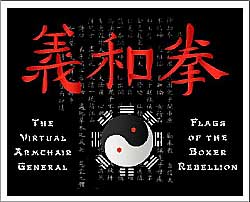
|
|
The Virtual Armchair General
|
The Boxers: More Than "Fanatics" And "Rioters" By Frontis Wiggins* The Boxers seem to have started as an offshoot of the "Heaven and Earth Societies" (Triads) whose roots were nationalistic, supporting the "Legitimate Chinese rulers of China" (the Ming) against the foreign Manchu invaders (the Qing). In fact, the earliest Boxer banners carried the same slogan as the Triad motto: "Overthrow the Qing, support the Ming." Earlier anti-Qing groups (The White Lotus Sect and the Heaven and Earth Societies) worked in varying degrees with other "rebellious" groups (the Anti-Opium groups, Nien rebels and the T'ai Ping). Initially, the Boxers referred to themselves as the I Ho Chuan ("The Righteous Harmonious Fists"). However, through the intercession and support of Qing officials (including the Dowager Empress, Tzu Hsi [or Cixi]), they were informally assimilated into the Qing forces and began to refer to themselves as the I Ho Tuan ("The Righteous Harmonious Militia"). A Tuan was the basic organizational unit for the Boxers, but the given number of members of a Tuan varied widely from 20 to over one hundred. There were female members of the movement, broken into different groups; young women (called the Red Lanterns, who could purportedly fly), widows, married women, etc (Green, Black and Blue Lanterns), as well as a sha kuo chao, "Cooking Pot Lanterns" who possessed "miraculous pots" that would magically refill themselves (whether the food was real sustenance or only spiritual is uncertain). The Red Lanterns in particular would drill and practice martial arts with the men and appeared in support of the combatants, probably in the role of a commissary. Their presence on the field was supposed to have imbued the men with greater morale. China has a long history of women combatants and martial arts experts going back centuries. There are many historically based stories of female generals and fighters (there are even several Beijing Operas on this theme, including The Female Generals of the Yang Family ) so the idea of female boxers involved in combat is plausible. Normally, the Chinese secret societies, like the Triads and by extension the Boxers, were organized based on seniority in the organization. The common appellation is "Brother" and someone senior to you is referred to as "Big Brother" or da ge (pronounced like "da" in Russian and "guh" as in "good"). Da ge can also mean "Leader" and everyone above your rank is simply "Big Brother." Another term, coined from Taoism is si fu (pronounced "see-foo") meaning "Master" and is usually reserved for a Taoist Shaman. Female members are referred to as Jie, or "Sister" (pronounced like the "jea" in "jealous") and da jie for "Big Sister." Boxer Banners, Taoism and Trigraphs Mysticism played a heavy role in ancient Chinese society and continues to do so in many Chinese communities today (most pronounced in Hong Kong and Taiwan, although it can still be found to a limited degree in Mainland China. I remember an interesting visit with a Taoist priest in X’ian in 2004). In addition, Chinese culture, like many others, tends to incorporate color and pageantry in many undertakings. For example, visit any business in China on its grand opening. Often times, the date and time of the opening will be derived from a Chinese almanac to select an auspicious time. The outside of the building will be festooned with colorful banners, balloons, awnings, flowers and plants. Lion dancers and drummers may be hired to make the occasion even more festive. The Chinese secret societies and military are no different, incorporating many colorful and symbolic displays in their routine. This article will focus specifically on the I Ho Chuan/Boxers and the elements of mysticism and pageantry included in their banners and practices. Background To this day, elements of Taoism can be found in feng shui (wind and water) practices. As part of the balancing of "the way" (Tao) with the 5 key elements of life (Wood, Metal, Earth, Water and Fire), and the life force (qi), a ba gua (eight-sided mirror containing mystical symbols or "Trigraphs") is used in conjunction with compasses, color schemes, birth dates/times and other Chinese calendar dates, geographic features, etc, to create harmonious working environments, anticipate the future, and take corrective action to improve fortune, improve health and prevent problems. This can be as basic as the positioning of doors, fish tanks, etc, to as complex as determining what day/time a major event should take place (a wedding, the birth of a child [caesarian sections are popular in Hong Kong for this reason] and the date and time to open a new business). Taoist elements are also found in the initiating ceremonies and day-to-day operation of the Chinese Triad Societies. Of interest, the original slogan of the Boxers ("Destroy the Qing, Restore the Ming") is also the founding tenet of the Heaven and Earth Societies/Triads (although that has been diluted over the centuries leaving them almost exclusively as criminal organizations, albeit with some ceremonies that hark back to the original, pro-Chinese nationalist movement). The ethnic Han Chinese of the Ming dynasty always viewed the Manchu (from Manchuria) as foreign invaders. The Boxers incorporated many mystical elements into their ceremonies and practices. In fact, one of their pseudonyms was the "8 Trigraph Sect/Society" (Ba Gua Hui). For this reason, many Boxer banners contained a Trigraph from the ba gua as an element of their flag. The ba gua, often found in homes and businesses, is normally made from wood. At the middle of the ba gua itself is usually a mirror or yin/yang symbol that represents the balance of competing natural elements, one of which is normally associated with female elements/influences (yin) and the other with more male elements/influences (yang). Several of the symbols have the same elemental association (two, Chen and Hsun, for wood and two, Tui and Ken, for metal) but each pair is associated either with yin or yang influence (i.e. Chen is wood with a yin influence, Hsun is wood with a yang influence, Tui is metal with yang, Ken is metal with yin). As the name implies, there are 8 mystical symbols on the ba gua (ba is Mandarin for “eight"). The Pinyin for the Trigraphs are: Kun, Chen, K'an, Tui, Ken, Li, Hsun (or Xun) and Q'ien (or Chien). Each symbol is made of 3 graphs, arranged horizontally, top, middle and bottom) and are themselves almost a code: The two short dashes of a Trigraph (--) represent yin while the single, long line ( __ ) represents yang. If you look at the symbols you'll notice that they are setup as pairs/opposites so that one symbol may be all yin (Kun/earth) and its opposite will therefore contain all yang (q'ien/heaven). Fire/Li read from top to bottom is yang/yin/yang so its opposite, K'an/water is yin/yang/yin. This also will show how one element for wood, Chen, is yin/yin/yang (yin influence) so its opposite, Hsun is yang/yang/yin (yang influence). Colors are also associated with the Trigraphs. Historical records mention that banners were seen that contained three of the Trigraphs: K'an, Q'ian and Kun. The symbol K'an can mean "water" but is also a homonym for "chop." The symbol Q'ian can mean "heaven" but is also a homonym for "spear." Banners would only contain a single Trigraph to represent the influence or sect of Boxers. It is theoretically possible that all 8 Trigraphs were used, although sources only site these three. It would seem likely that, based on the Taoist influences, that normal Shaman or Monk paraphernalia would be seen on the field of action: Portable altars were noted by contemporaries as were an array of weapons, including Chinese spears, pole arms, tridents and swords, as well as unusual items such as iron rings with daggers attached. Taoist Shamans/Monks would normally have ba guas, lo pan compasses, "Hell Money," "Hell Coins," coin swords, joss sticks, and be dressed in distinctive robes and head-gear. Slogans appearing on banners would include words like sha ("Kill") and mie ("Destroy") and the names of the towns where the sects are from. Conclusion The Boxers were one in a long line of nationalist movements that incorporated spiritual elements into their beliefs and practices. They are the most famous in the West, due to the siege of the Legations and the Eight Powers intervention. However, they should not be viewed in isolation, but seen as a single element in a continuous flow of spiritualism and nationalistic movements and emphasis that continues to this very day, both internally to China and externally in Chinese cultural enclaves around the world. Sources: Heath, Ian; Armies of the 19th Century: Asia, China China Peace Publishing House; Atlas of Flags in China * Frontis Wiggins is a Foreign Service Officer who is a lifelong war gamer and spent 3 years in Beijing and 4 ˝ year in Hong Kong. Return to 19th Century Chinese Flags Collection Main Page. Return to "Righteous Harmonious Fists" Flags Page
| |

